In Greek is the word "scolios", which translates as "crooked."With this word, doctors denote the curvature of the spine.In addition, not all curvature, namely, the lateral deviation of the vertical axis of the spine.The fact is that normally our spine is not perfectly uniform.The curves available in the front and posterior (lithosis and kyphosis) protect our column from excessive loads while keeping the body in a certain position when moving and wearing weights.The negative processes in our body are developed only in cases where these kyphosis and landes are expressed in excess of the allowed norm.
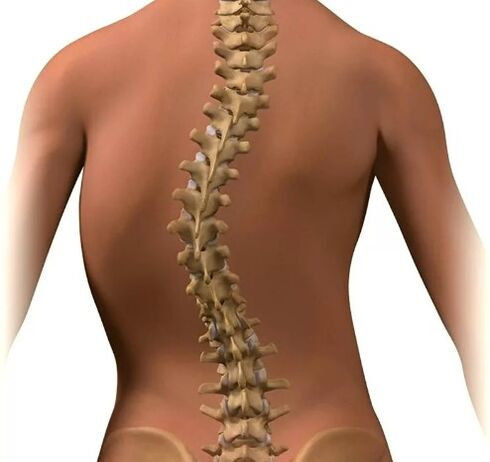
The main problems
However, even a small degree of lateral curves (scoliosis) of the spine is always a pathology.And the point is not alone in a cosmetic defect.Although a characteristic repulsive appearance with pronounced or progressive scoliosis is always a tragedy for a person who seeks to live a full quality of high quality.This is especially true for young children.In fact, it is in the period of children and youth (up to 15 to 16 years) that a significant part of scoliosis is diagnosed.
The main problem is that due to a change in the configuration and volume of the chest with pronounced lateral curvature, the internal organs always suffer (heart, lungs, stomach, liver, intestines, large glasses).In men, physical effort tolerance decreases, women have problems with conception, pregnancy and motherhood.In addition, very often the lateral deformation of the spine is only the superficial part of the iceberg, which is a sign of a much more serious pathology: tumor, tuberculosis, endocrine disorders.
Reasons
So why is the column deforms?Before answering the question, you must decide on the types of scoliosis.In its nucleus, scoliosis can be structural and non -structural.Structural scoliosis develops due to anatomical changes in the structure of the bone tissue of the vertebrae, as well as the muscles, nerves and ligamentums located nearby.These curvatures can be acquired and congenital, and approximately a quarter of all diagnosed scoliosis represent the latter.
Among the main reasons for the development of structural scoliosis, they distinguish:
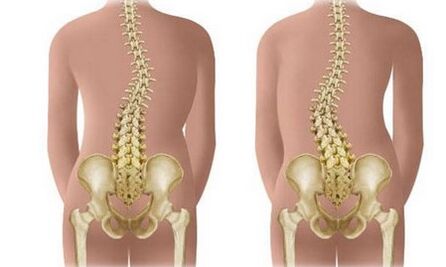
- Intrauterine development masts that lead to dysplastic disorders of one or more vertebrae
- Abnormalities of congenital chest development: lack of ribs, additional ribs
- Congenital pathology of connective tissue: neurofibromatosis, ivan syndrome
- Cerebral miss
- Osteoporosis (bone tisage) of the column in the rickets, diseases of the parathyroid glands, lack of calcium intake with food with food
- Osteomyelitis of the vertebrae
- Distrophic changes in cervical, thoracic and lumbar muscles
- Tuberculosis damage to vertebrae
- Column injuries
- Spine tumors.
Non -structural scoliosis, as follows of the name, are the lateral deviations of the spinal column axis with the structure without changes in vertebrae.As a general rule, this scoliosis is acquired more frequently with the exception of cases in which the curvature is of compensatory nature with congenital anatomical defects of the pelvis or lower limbs.The causes of such scoliosis are more frequently:
- Pelvic lesions and lower limbs
- Congenital defects of the pelvis and the lower limbs
- Constant inadequate posture in schoolchildren
- Internal organ diseases with asymmetrically expressed pain syndrome
- Muscle inflammation (myosites)
- Burns, soft fabric scars on one side.
In these cases, to eliminate the curvature of the spine, it is sufficient to cure the underlying disease and, therefore, many unstructural scoliosis are easily reversible.In this sense, some doctors tend not to consider non -structural deformations for scoliosis in general.
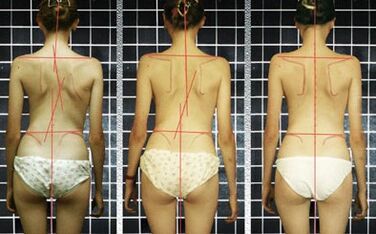
Recently, cases of scoliosis development with unclear causes have become more frequent.This is the idiopathic scoliosis called like this.It occurs in the youth years, during the rapid growth period of the body.In addition, girls suffer from idiopathic scoliosis several times more often than young men.Apparently, this is due to the relatively weak muscles of the back of the female, which cannot enclose the column into a complete muscle frame.An unbalanced diet with low calcium salts and a general passion for young people with carbonated drinks play a final role in the development of idiopathic scoliosis.As you know, carbon dioxide in bubbles and orthophosphahic acid in synthetic inclusions contributes to the leaching of calcium salts of the body.
Varieties and titles
Depending on the location, scoliosis can be cervical, chest, lumbar or mixed (cervical, lumbosacro).It is possible to have one or more arches of curvature.In this sense, the scoliosis in the form of C (with 1 arc), in the form of S (with 2 arches) and in the form of Z (with 3 arches) are distinguished.Most likely, the presence of 2 or 3 arches is compensatory.With C -shaped scoliosis, the axis of the spinal column deviates.In an effort to compensate for this, the column bends in the opposite direction.In this sense, scoliosis is divided into compensated and not compensated.In the compensated spinal curvature, a low vertical line of the seventh cervical vertebra passes through the fold between the buttocks.
The curvature of the column is often combined.For example, in the thoracic region, in addition to the lateral curvature, pathological kyphosis is observed, or simply a hump.In these cases, speaking of thoracic kyphoscoliosis.In addition, with large degrees of scoliosis, in addition to the lateral displacement of the vertebrae, Thuria is observed.In a literal translation, this means twisting.In fact, with many scoliosis, vertebral bone tissue is twisted along the vertical axis.
Depending on the size of the angle of the arc of the curvature, 4 degrees of scoliosis are distinguished:
- 1 grade- The angle of curvature does not exceed 10 degrees.The asymmetry in the eyes is practically not determined.The stopop, the design level of the shoulder girdle, pays attention.
- 2 degrees- The angle of curvature is 11 to 25 degrees.In this sense, the vertebrae are already observed.There is an asymmetry of the shoulder tape and the pelvis that is visible in the eye.Due to pathological muscle tension, a muscular roller is formed in the lumbar region from the concave side, and in the chest area with a convex.
- 3 degrees- Wrtification is 26 to 50 degrees.Visible deformation of the chest: The west of the intercostal spaces C on the concave side of the curvature and bulky with convex.Weakening of the abdominal press, the formation of an internal hump.
- 4 degrees- The angle of curvature and exceeds 50 degrees.A cosmetic defect and all the previous signs are expressed.Low tolerability of even a small physical effort.In addition to the musculoskeletal system, internal organs suffer.
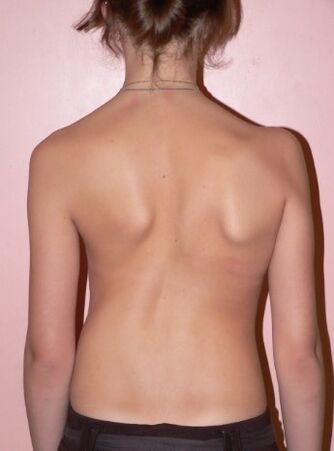
The angle can vary according to the position of the body, while stable and unstable scoliosis is distinguished.With unstable scoliosis, it decreases in the liar position when the load in the spine decreases.With a stable curvature of the column, this value remains unchanged.
Symptoms
Recently, orthopedists often use the term "scoliotic disease."And indicate a complex of negative changes that occur in the body during the curvature of the spine.As a general rule, scholastic disease develops in childhood and adolescence, during the formation of the musculoskeletal system.At this time, there is a high probability that scoliosis progressing.
Apparently, intervertebral discs play an important role in increasing the angle of curvature.With a lateral displacement, the disc experiences an unequal pressure of the vertebral bodies.On the concave side, this pressure is greater, with a convex, less.As a result of this, the album wears out even more of scoliosis, a pathological muscle tension (muscular roller) and the torsion of the vertebrae are created, all this leads to the appearance of hernias in disk and to an additional increase in the angle of curvature.
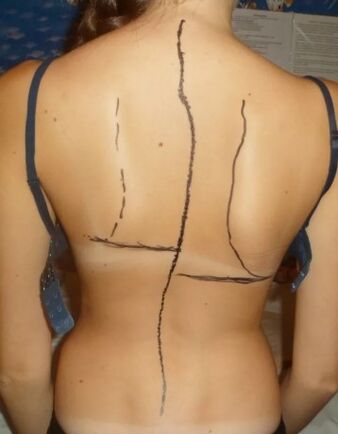
Together with the spine with a scoliotic disease, the chest changes in second place.The SO rib is formed, on the convex side of the curvature, the intercostal spaces expand, and from the concave, on the contrary, they are sown.With the fourth grade scoliosis, the deformation of the chest is so pronounced that the lower ribs on the curvature side are in contact with the rowing of the iliac bone.
Due to the severe deformation of the chest, a complete excursion is difficult during breathing.As a result, the body with severe scoliosis does not receive the required amount of oxygen: chronic hypoxia called So develops with a violation of all metabolic processes in the body.The pathology is aggravated by the fact that the internal volume and shape of the thoracic cavity change.Because of this, blood circulation is altered through the vessels, the lungs suffer, the shape of the heart changes, chronic cardiovascular failure develops.
Similar changes occur in abdominal organs for lumbar and lumbosacral scoliosis.Stomach engines and intestines are reduced with posterior enzymatic insufficiency of digestive glands.All this only exacerbates metabolic disorders.These violations often lead to late sexual maturation of boys and girls.In addition, due to lumbar scoliosis, the pelvis curves for the second time.This creates problems for future mothers with gestation and maternity.
Diagnosis
The diagnosis of scoliosis, especially large degrees, as a rule, is not difficult.To detect the deformation of the spine, a common visual examination is often enough.The visible curvature of the contours of the column, the asymmetry of the shoulder waist, the angles of the shoulder blades, the secondary curvature of the pelvis and the shortening of the lower limb on the side of the curvature are notable.
In the presence of at least one of these signs, the radiography of the spine is indicated.The X line determines the configuration, degree and location of the curvature.During inspection and radiological examination, it is possible to establish whether scoliosis is compensated and stable.Recently, a qualitatively new research method of the Magnetic Resonance Resonance of the spine (MRI) has been extended, during which a three -dimensional image of the spine can be obtained on the monitor screen.With significant curvatures, it is necessary to investigate the work of the internal organs: carry out a spirometry, electrocardiography and carry out an ultrasound of the heart and internal organs.
Treatment
The treatment of scoliosis can be carried out conservatively and quickly.Conservative methods include pharmacological treatment, massage, physiotherapeutic procedures and manual therapy.It should be taken into account that the final formation of the column ends at the age of 20, and after this age, the correction of the curvature is almost impossible.With 1-2 degrees scoliosis, efforts are intended to achieve the initial and normal configuration of the spine.With the pronounced scoliosis of the third to 4th grade, this is unattainable, the main thing here is to stabilize the column and prevent the progression of scoliosis.

Medications (condoprotectors, vitamins, general strengthening of strengthening) in the treatment of scoliosis play only an auxiliary role.To strengthen the muscles, eliminate the muscular roller and even to a large extent to stabilize the spine with the help of massage and manual therapy.Physiotherapy exercises give a good effect.But here, with inappropriate physical effort, the instability of the spine increases and scoliosis progresses.Therefore, a set of exercises is developed for each patient individually, taking into account the location and severity of the curvature.With a large degree of scoliosis, race, strength exercises, jumps, outdoor games are contraindicated.
A very good result gives correction by the position: the optimal pose that contributes to the standardization of the position is created.For this, special devices, orthopedic cribs in which young patients spend a significant part of their time are used.With the inefficiency of conservative measures, the progression of curvature is indicated, surgical treatment intended to stabilize the spine.Surgical correction is not shown in early childhood, it is carried out in adolescence, when column formation is almost completed.

















































